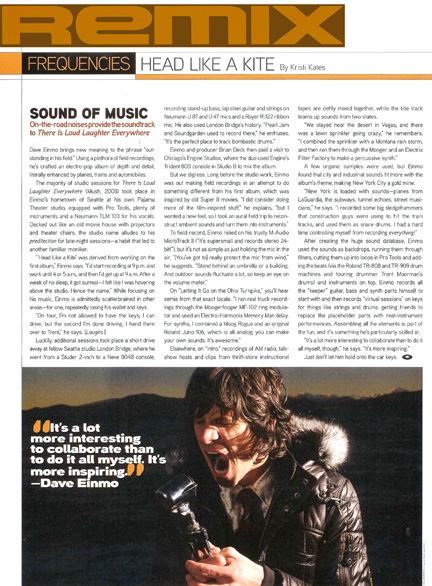
SOUND OF MUSIC
ON-THE ROAD NOISES PROVIDE THE SOUNDTRACK TO THERE IS LOUD LAUGHTER EVERYWHERE
Dave Einmo brings new meaning to the phrase “outstanding in his field.” Using a plethora of field recordings, he’s crafter an electro-pop album of depth and detail, literally enhanced by planes, trains, and automobiles.
The majority of studio sessions for There Is Loud Laughter Everywhere (Mush, 2008) took place in Einmo’s hometown of Seattle at his own Pajama Theater Studio, equipped with Pro Tools, plenty of instruments, and a Neumann TLM 103 for his vocals. Decked out like an old movie house with projectors and theater chairs, the studio name alludes to his predilection for late-night sessions – a habit that led to another familiar moniker.
“’Head Like A Kite’ was derived from working on the first album,” Einmo says. “I’d start recording at 9 p.m. and work until 4 or 5 a.m., and then get up at 9 a.m. After a week of no sleep, it got surreal – I felt like I was hovering above the studio. Hence the name.” While focusing on his music, Einmo is admittedly scatterbrained in other areas – for one, repeatedly losing his wallet and keys.
“On tour, I’m not allowed to have the keys; I can drive, but the second I’m done driving I hand them over to Trent,” he says. [Laughs]
Luckily, additional sessions took place a short drive away at fellow Seattle studio London Bridge, where he went from a Studer 2-inch to a Neve 8048 console, recording stand-up bass, lap steel guitar and strings on Neumann U 87 and U 47 mics and a Royer R-122 ribbon mic. He also used London Bridge’s history. “Pearl Jam and Soundgarden used to record there,” he enthuses. “It’s the perfect place to record bombastic drums.”
Einmo and producer Brian Deck then paid a visit to Chicago’s Engine Studios, where the duo used Engine’s Trident 80B console in Studio B to mix the album.
But we digress. Long before the studio work, Einmo was out making field recordings in an attempt to do something different from his first album, which was inspired by old Super 8 movies.
“I did consider doing more film-inspired stuff,” he explains, “but I wanted a new feel, so I took an aural field trip to reconstruct ambient sounds and turn them into instruments."
To field record, Einmo relied on his trusty M-Audio MicroTrack II (It’s supersmall and records stereo 24 bit!”), but it’s not as simple as just holding the mic in the air. “[You’ve got to] really protect the mic from the wind,” he suggests. “Stand behind an umbrella or a building. And outdoor sounds fluctuate a lot, so keep an eye on the volume meter.”
On “Letting It Go On The Ohio Turnpike,” you’ll hear semis from that exact locale. “I ran real truck recordings through the Moogerfooger MF-102 ring modulator and used and Electro-Harmonix Memory Man delay. For synths, I combined a Moog Rogue and an original Roland Juno-106, which is all analog; you can make your own sounds. It’s awesome.”
Elsewhere, on “Intro,” recordings of AM radio, talk-show hosts and clips from thrift-store instructional tapes are deftly mixed together, while the title track teams up tracks from two states.
“We stayed near the desert in Vegas, and there was a lawn sprinkler going crazy,” he remembers. “I combined the sprinkler with a Montana rain storm, and then ran them through the Mooger and an Electrix Filter Factory to make a percussive synth.”
A few organic samples were used, but Einmo found that city and industrial sounds fit more with the album’s theme, making New York City a gold mine.
“New York is loaded with sounds – planes from LaGuardia, the subways, tunnel echoes, street musicians,” he says. “I recorded some big sledgehammers that construction guys were using to hit the train tracks, and used them as snare drums. I had a hard time controlling myself from recording everything!”
After creating the huge sound database, Einmo used the sounds as backdrops, running them through filters, cutting them up into loops in Pro Tools and adding the beats (via the Roland TR-808 and TR-909 drum machines and touring drummer Trent Moorman’s drums) and instruments on top. Einmo records all the “keeper” guitar, bass and synth parts himself to start with and then records “virtual sessions” on keys for things like strings and drums, getting friends to replace the placeholder parts with real-instrument performances. Assembling all the elements is part of the fun, and it’s something he’s particularly skilled at.
“It’s a lot more interesting to collaborate than to do it all myself, though,” he says. “It’s more inspiring.”
Just don’t let him hold onto the car keys.
KRISTI KATES